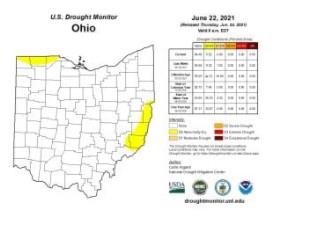By Stan Smith
Today, the U.S. Drought Monitor suggests little of Ohio is in moderate drought, or even abnormally dry. Despite what their map might show, in much of Fairfield County, especially in the northwest third, we have experienced barely 2 inches of rain over the past 7 and a half weeks, and only 0.3 inch over the past nearly 3 weeks. It appears many parts of Ohio are experiencing similar rain patterns. Knowing this, its apparent pasture across much of the state is, or very soon will be, showing the negative impact of dry soils and high soil surface temperatures.

The U.S. Drought Monitor may not show it, but parts of Ohio are very dry!
Regardless, it is never too soon to employ summer pasture management strategies in order that forage growth can quickly begin again once adequate precipitation returns. Most importantly, cool season pasture grasses should not be grazed to less than 4 inches in height and should be 8 inches or more before allowing cattle to re-enter a pasture or paddock. If pastures aren’t able to recover to at least 8 inches, the short-term solution is to limit the area the cattle can access, and feed hay.
For more detail on strategies that can ultimately allow pastures to recover more quickly once rain fall returns, and extend the grazing season later into fall, see these two articles that were previously published in the Ohio BEEF Cattle letter:
Source : osu.edu